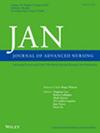Changed Personal Attitudes Predict Sexual Behaviours Among Men Living With HIV in the Era of U=U: A Half-Longitudinal Study.
IF 3.4
3区 医学
Q1 NURSING
引用次数: 0
Abstract
INTRODUCTION In the era of 'Undetectable = Untransmittable' (U=U), reductions in condom use and increases in casual partnerships may contribute to elevated risks of coinfection with other sexually transmitted infections (STIs) and HIV super-infections among men living with HIV. These trends may reflect a shift in personal attitudes towards sexual behaviour and HIV risk, yet their influence on actual behaviours remains unclear. AIM To investigate how changes in personal attitudes and safe sex self-efficacy influence sexual decision-making. DESIGN Two-wave longitudinal study design. METHODS We conducted a 3-month longitudinal study from March to December 2023 among HIV-positive men (≥ 18 years) initiating ART in Changsha, China. Cross-lagged panel analysis and half-longitudinal mediation analysis were used to examine how changes in personal attitudes influenced sexual behaviours. RESULTS 427 men living with HIV were included at baseline, and 301 completed the follow-up survey. Sexual behaviours were associated with personal attitudes, namely safe sex fatigue, viral load/transmission beliefs, and sexual sensation seeking. More positive personal attitudes in these domains at baseline predicted lower safe sex self-efficacy over 3 months, while reduced baseline self-efficacy increased the likelihood of engaging in condomless sex and/or multiple sexual partners. All three personal attitude domains had significant indirect effects on sexual behaviours via safe sex self-efficacy. CONCLUSION In the era of U=U, the changed personal attitudes among men living with HIV may lead to the increased likelihood of engaging in condomless sex and/or having multiple sexual partners, and safe sex self-efficacy serves as a mediator in this relationship. IMPACT This study highlights the potential influence of attitudinal changes on sexual behaviours among men living with HIV in the 'U=U' era. Findings provide valuable evidence for developing more targeted interventions that address not only behavioural outcomes but also underlying personal attitudes. PATIENT OR PUBLIC CONTRIBUTION No patient or public contribution.U=U时代个人态度的改变预测HIV感染者的性行为:一项半纵向研究。
在“检测不到=无法传播”(U=U)的时代,避孕套使用的减少和随意伴侣关系的增加可能导致艾滋病毒感染者与其他性传播感染(sti)合并感染和艾滋病毒超级感染的风险增加。这些趋势可能反映了个人对性行为和艾滋病毒风险态度的转变,但它们对实际行为的影响尚不清楚。目的探讨个人态度和安全性行为自我效能感的变化对性行为决策的影响。设计双波纵向研究设计。方法:我们于2023年3月至12月在中国长沙开展了一项为期3个月的纵向研究,研究对象为接受抗逆转录病毒治疗的hiv阳性男性(≥18岁)。交叉滞后面板分析和半纵向中介分析用于研究个人态度的变化如何影响性行为。结果基线时纳入427例男性HIV感染者,301例完成随访调查。性行为与个人态度有关,即安全性行为疲劳、病毒载量/传播信念和性感觉寻求。在基线时,这些领域中更积极的个人态度预示着3个月后安全性行为自我效能的降低,而基线自我效能的降低增加了从事无安全套性行为和/或多性伴侣的可能性。三个个人态度域均通过安全性行为自我效能对性行为有显著的间接影响。结论在U=U时代,HIV感染者个人态度的改变可能导致其发生无套性行为和/或拥有多个性伴侣的可能性增加,而安全性行为自我效能感在这一关系中起中介作用。影响本研究强调了在“U=U”时代,态度变化对艾滋病毒感染者性行为的潜在影响。研究结果为制定更有针对性的干预措施提供了有价值的证据,这些干预措施不仅涉及行为结果,还涉及潜在的个人态度。病人或公众捐款:没有病人或公众捐款。
本文章由计算机程序翻译,如有差异,请以英文原文为准。
求助全文
约1分钟内获得全文
求助全文
来源期刊
CiteScore
6.40
自引率
7.90%
发文量
369
审稿时长
3 months
期刊介绍:
The Journal of Advanced Nursing (JAN) contributes to the advancement of evidence-based nursing, midwifery and healthcare by disseminating high quality research and scholarship of contemporary relevance and with potential to advance knowledge for practice, education, management or policy.
All JAN papers are required to have a sound scientific, evidential, theoretical or philosophical base and to be critical, questioning and scholarly in approach. As an international journal, JAN promotes diversity of research and scholarship in terms of culture, paradigm and healthcare context. For JAN’s worldwide readership, authors are expected to make clear the wider international relevance of their work and to demonstrate sensitivity to cultural considerations and differences.

 求助内容:
求助内容: 应助结果提醒方式:
应助结果提醒方式:


